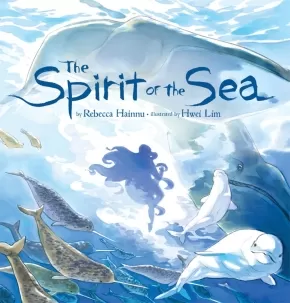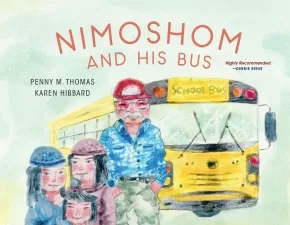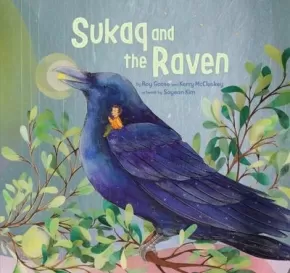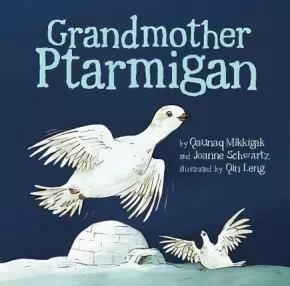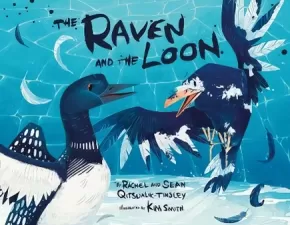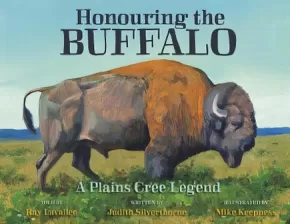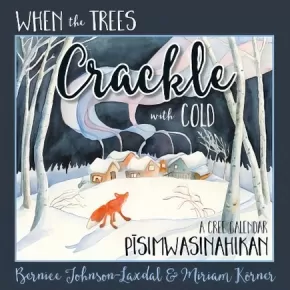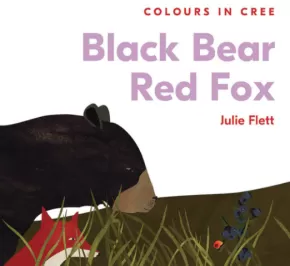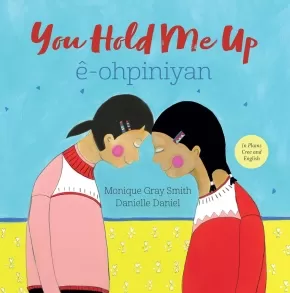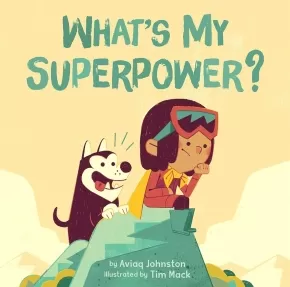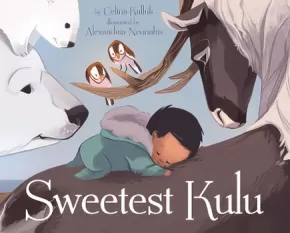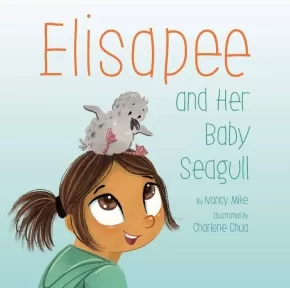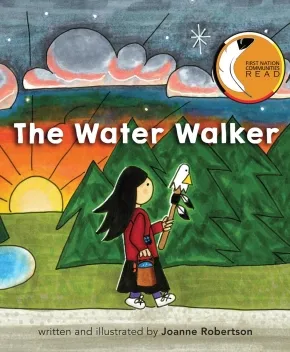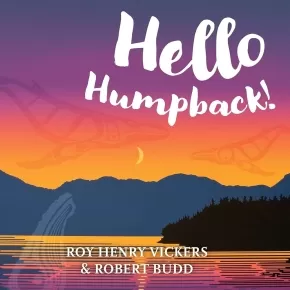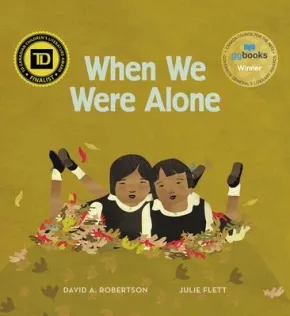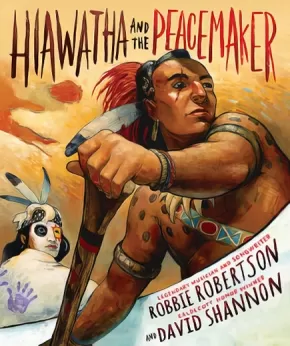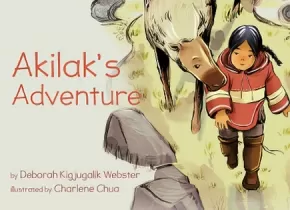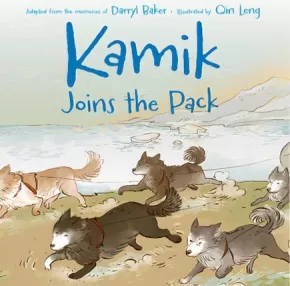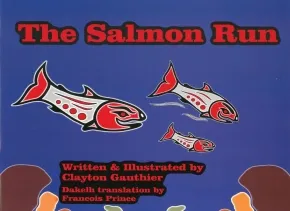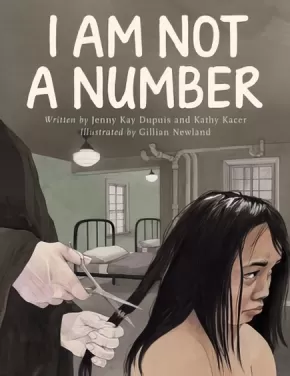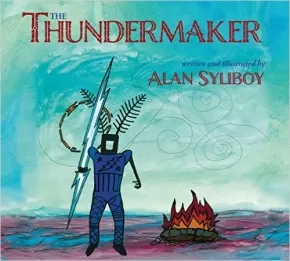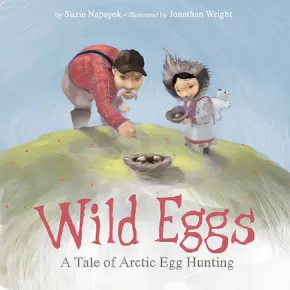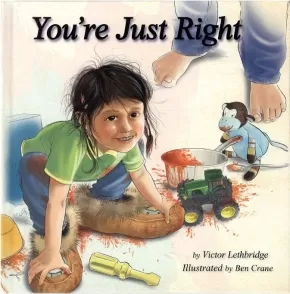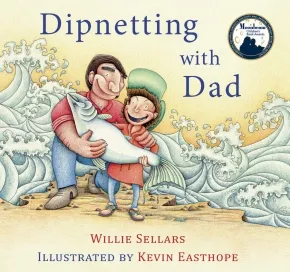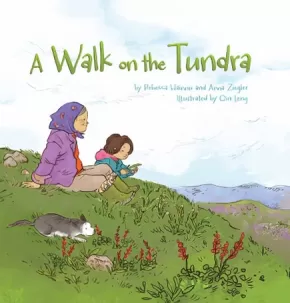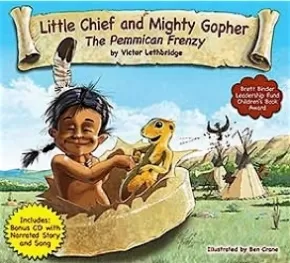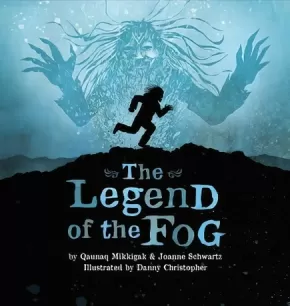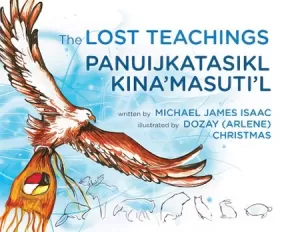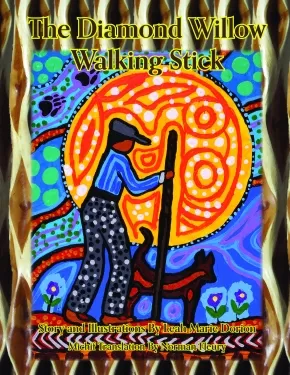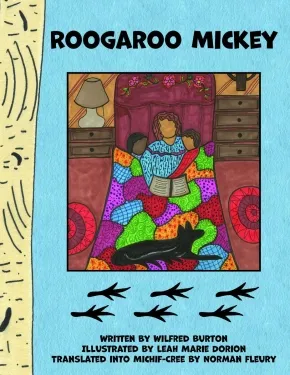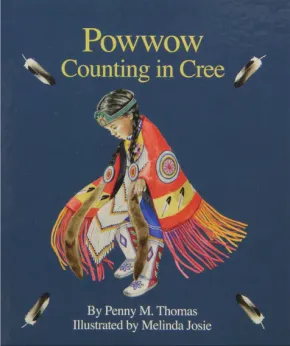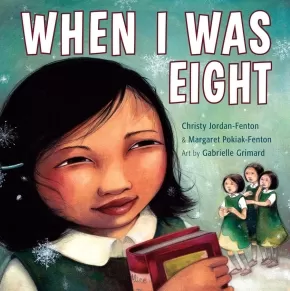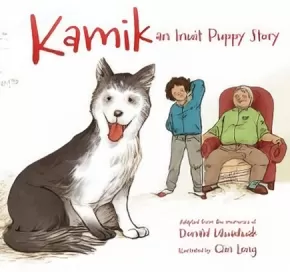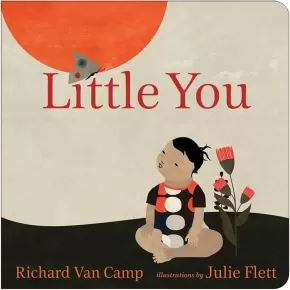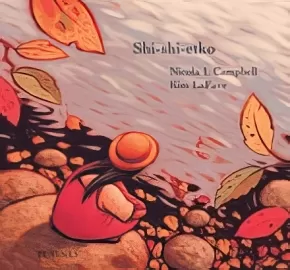
From Sea to Sea to Sea 2018 Edition
1
-
15
of
76 Results;
Sort By
Go To
of 6
The Spirit of the Sea (PB)
$14.95
Artists:
● Hwei Lim
Format: Paperback
Text Content Territories:
Indigenous Canadian; Inuit;
ISBN / Barcode: 9781772275216
Synopsis:
Synopsis:
This beautifully illustrated picture books tells the story of the spirit of the sea, referred to as Nuliajuq, Sedna, Takannaaluk, and many other Inuktitut names.
Once a young woman who refused to marry, the lies and deceit of a treacherous bird—and her own father's cowardice—lead Nuliajuq to a life of solitude at the bottom of the ocean as the powerful, at times vengeful, spirit of the sea.
The Spirit of the Sea provides young readers with an authentic retelling of one of the most important, powerful legends in the canon of Inuit traditional stories.
Reviews
"The text, which is appropriate for upper elementary readers and above, is meant to be read aloud and generally has the sound of a traditional storyteller’s voice. The watercolours by Hwei Lim are beautiful and ethereal. The Spirit of the Sea is highly recommended for elementary school libraries, public libraries and libraries specializing in Canadian Indigenous materials."—Deakin Review
"The Spirit of the Sea would be great for reading aloud [and] independent reading."—Canadian Teacher
Educator Information
Recommended for ages 6 to 8.
Additional Information
32 pages | 8.75" x 8.75" | Paperback
Nimoshom and His Bus (PB)
$14.00
Artists:
Format: Paperback
Text Content Territories:
Indigenous Canadian; First Nations; Cree (Nehiyawak);
Grade Levels: Preschool; Kindergarten;
ISBN / Barcode: 9781774921166
Synopsis:
Synopsis:
In this warm and joyful picture book highly recommended by Debbie Reese, children learn Cree from Nimoshom, their school bus driver.
Based on the author’s memories of her grandfather, Nimoshom is not your average bus driver. He loves to drive the school bus, tell silly stories, and share his language with the kids who ride his bus.
Nimoshom and His Bus introduces readers to common Cree words and phrases alongside the common childhood experience of riding the school bus. A Cree word list is included in the back of the book.
Reviews
"Through accessible language and engaging visual resources, readers are introduced to basic Cree as Nimoshom responds in this language to the children who ride his bus.... The illustrator’s varying the visuals between full double spreads and single page illustrations keeps the pacing lively. Amidst a rural fall setting, with woodland animals, children, and the school bus, Nimoshom’s humorous nature shines through these gentle illustrations. At the end of this story, you just want to give Nimoshom a great big hug!"— Anita Miettunen, CM: Canadian Review of Materials
"In this bilingual book, readers follow a bus driver picking up kids and dropping them off before and after school. Like the students on the bus, readers quickly learn that the driver's native language is Cree, and he often speaks to them in his native language. Readers learn that "Nimoshom" means "my grandfather" and that "Ekosani" means thank you" as the author (of Cree descent herself) weaves Cree words into the text, and each new spread almost feels like a gentle wave: yes, we're subtly learning new words, but it never feels strenuous or forced, rather it's calm and poetic."— Let's Talk Picture Books
"While Penny M. Thomas' story is not a plot-driven allegory or a message-based lesson, Nimoshom and His Bus is a sweet introduction to some simple Cree words in the context of a common-place activity for many children.... Karen Hibbard who uses watercolours and pastels to create a gentle background for Nimoshom's day on his bus gives the story a grassroots mood, highly appropriate for a routine day of activity and interaction for this bus driver and his charges. It's very relatable."— Helen Kubiw, CanLit for Little Canadians
"If you're a regular reader of AICL, you know that we're always delighted by books by Native writers--especially ones set in the present. Books like Nimoshom and His Bus provide Native children with mirrors that non-Native children find in abundance.... I highly recommend Nimoshom and His Bus! It'd be a simple thing to use other Native words in addition to--or instead of--the Cree words in the book."— Debbie Reese, American Indians in Children's Literature
"In a busy world where many children and adults miss out on time spent together sharing lived experiences, Penny M. Thomas reminds her readers of the healthy relationships that can develop when adults and children interact meaningfully. Through Nimoshom and His Bus, she showcases the importance of these interactions and the positive impact they can have on both children and adults." - Debra H., Elementary School Teacher, Indigenous Books for Schools
Educator Information
Recommended for ages 3 to 5.
This book is included in the Indigenous Books for Schools database from the Association of Book Publishers of BC. It is recommended for K to 3 classrooms for Career Education, English Language Arts, and Social Studies.
Additional Information
24 pages | 9.50" x 7.50" | Paperback
The Spirit Trackers (PB)
$14.95
Artists:
Format: Paperback
Text Content Territories:
Indigenous Canadian; First Nations; Anishinaabeg;
ISBN / Barcode: 9781771770187
Synopsis:
Synopsis:
Will and Tom speak in a whisper.
"Uncle, tell us the story of the Windigo."
The boys look behind them for something they can't see.
When Uncle shares the story of the Windigo, the cousins get more than they expect. That night something strange scratches at the frost on their bedroom window. In the morning they find huge tracks in the snow. The Wandering Night Spirit of Winter!
Tom and Will know what good Trackers would do, so they follow the trail deep into the forest. Then a strange cry slices the air.
"Remember," Will whispers as they move forward. "Don't look into its eyes."
Can you be a tracker too? Find the tracks hidden in the pictures.
Reviews
"Gorgeous illustrations and suspenseful writing fully engross the reader and have my kids sitting on the edge of their seats every time. This emotional engagement makes it a perfect read for discussing the concept of bravery, while the story's details provide wonderful cultural education. And as a fun bonus, the endpapers show different animal tracks that you can spot throughout the book - just like good Trackers!"— Read. Learn. Repeat. Blog
"Richly illustrated in mixed media, Waboose weaves a story of respect for nature and family. The boy's insistence of their bravery is countered by their natural fear of the unknown — and the stories they have heard. A great read for a stormy winter night. Beware of the Windigo!"— kissthebookjr.blogspot.com
"Anishinaabe Waboose's prose seamlessly threads her people's legends with her story of a modern First Nations family that is keeping its traditions alive. Award-winning illustrator Thisdale's expressive and detailed illustrations add depth to Waboose's engaging text. His mixed-media paintings successfully blend the traditional and the modern, the comfortably familiar and the uncanny, to support the story's themes. An intergenerational tale that celebrates both a specific tradition and the universal curiosity of children."— Kirkus Starred Review
Educator Information
Recommended in the Canadian Indigenous Books for Schools 2019-2020 resource list as being useful for grades K-4 for English Language Arts.
Young readers will be able to improve their tracking skills as they find clues hidden in the illustrations along with Will and Tom.
Additional Information
32 pages | 8.50" x 11.00" | Paperback
Sukaq and the Raven (PB)
$13.95
Artists:
Format: Paperback
Text Content Territories:
Indigenous Canadian; Inuit;
ISBN / Barcode: 9781772274349
Synopsis:
Synopsis:
Sukaq loves to drift off to sleep listening to his mother tell him stories. His favourite story is the tale of how a raven created the world. But this time, as his mother begins to tell the story and his eyelids become heavy, he is suddenly whisked away on the wings of the raven to ride along as the entire world is formed! This traditional legend from Inuit storyteller Roy Goose is brought to life through co-author Kerry McCluskey's jubilant retelling.
Additional Information
36 pages | 9.25" x 9.25" | Paperback
Grandmother Ptarmigan (BB)
$10.95
Artists:
● Qin Leng
Format: Board Book
Grade Levels: Preschool;
ISBN / Barcode: 9781772273656
Synopsis:
Synopsis:
It's bedtime for baby ptarmigan, but he will not go to sleep. So his grandmother decides to tell him a bedtime story that he will never forget.
With delightful illustrations by Qin Leng, this nursery rhyme–inspired rendition of a traditional Inuit origin tale is perfect for the youngest of children.
Published for the first time as a board book under the Inhabit Junior imprint, this book is perfect for the smallest of hands.
Educator Information
Recommended for ages 2 and under.
Additional Information
28 pages | 7.00" x 7.00" | Board Book
The Raven and the Loon (PB)
$12.95
Artists:
Format: Paperback
Text Content Territories:
Indigenous Canadian; Inuit;
ISBN / Barcode: 9781772272703
Synopsis:
Synopsis:
In the time before animals were as they are today, Raven and Loon were both white. Their feathers had no colour at all. Raven spent his days swooping through the sky trying to fight off his incessant boredom, while loon spent her days in her iglu working away on her sewing. One day, too bored to even fly, Raven visited Loon and suggested a sewing game that would give their feathers some much-needed colour. The results—not at all what the two birds expected—led to Raven and Loon acquiring their now-familiar coats.
This whimsical retelling of a pan-Arctic traditional story features lively, colourful illustrations from Kim Smith.
Educator Information
Recommended for ages 3-5.
Additional Information
32 pages | 9.25" x 7.30"
Honouring the Buffalo: A Plains Cree Legend
$19.95
Artists:
Format: Paperback
Text Content Territories:
Indigenous Canadian; First Nations; Cree (Nehiyawak); Plains Cree;
ISBN / Barcode: 9781927756331
Synopsis:
Synopsis:
"A long time ago, Our People came from the Northern Woodlands to the Great Plains looking for food," Grandfather said. "They saw that the Buffalo lived in harmony with Mother Earth the same as Our People did."
Through the Creator, the buffalo gave themselves as a gift for the sustenance and survival of the Plains Cree people. The largest land animal in North America once thundered across the Great Plains in numbers of 30 to 50 million. They provided shelter, food, clothing, tools, hunting gear, ceremonial objects and many other necessities for those who lived on the Plains.
But by 1889, just over a thousand buffalo remained, and the lives of the Plains Cree people changed. The buffalo is honoured to this day, a reminder of life in harmony with nature as it was once lived. This is the story of how the buffalo came to share themselves so freely.
Educator Information
The text is in English and y-dialect Plains Cree. Y-dialect Plains Cree translation by Randy Morin, Jean Okimasis, and Arok Wolvengrey.
This resource is also available in French: Hommage au bison.
Additional Information
48 pages | 11.00" x 8.50"
We All Count: Book of Ojibway Art (BB)
$12.00
Artists:
Format: Board Book
Text Content Territories:
Indigenous Canadian; First Nations; Anishinaabeg; Ojibway;
Grade Levels: Preschool; Kindergarten;
ISBN / Barcode: 9781554763962
Synopsis:
Synopsis:
Adair’s Woodland style of painting is the highlight in this counting board book written in Ojibway and English. Beautifully designed birds and other wildlife sit against flat planes of colour in tones and shades ranging from bright reds to vibrant purples to pale blues. This is a gorgeous book for the very young that opens their eyes to art and their ears to language. An excellent introduction to Ojibway numbers, highlighting the culture’s deep relationship with animals.
First in a series, this book showcases Ojibway art and culture and teaches children to count in English and Ojibway.
Last Leaf, First Snowflake to Fall
$12.99
Artists:
Text Content Territories:
Indigenous Canadian;
ISBN / Barcode: 9781554981243
Synopsis:
Synopsis:
Last Leaf First Snowflake to Fall takes us on a dreamlike voyage into nature at that secret moment when fall turns into winter. We find ourselves in a kind of paradise, which humans may be part of but which they have not despoiled.
A father and son lead us through forests, down rivers, over lakes and ponds. Along the way we experience the primordial beauty of the physical world. This is nature as we all feel in our hearts it must once have been.
Through lyrical words and a masterful collage technique, Leo Yerxa has created an exquisite and poetic evocation of this moment.
Educator Information
Curriculum Connections: Science and Nature, Visual Arts, Language Arts.
Recommended ages: 5-8.
Additional Information
32 pages | 8.13" x 11.00"
When the Trees Crackle with Cold: A Cree Calendar - Pisimwasinahikan
$14.95
Artists:
Format: Paperback
Text Content Territories:
Indigenous Canadian; First Nations; Cree (Nehiyawak);
ISBN / Barcode: 9781927756935
Synopsis:
Synopsis:
A bear sleeping safely in her den, Kohkom telling a story by the fire, the trees crackling with cold—we are all connected to the seasons and the cycle of nature. The calming rhythm of the words echoes the rhythm of the land in this timeless picture book about the moon calendar of the northern Cree, and its warmly rendered watercolour illustrations bring Saskatchewan’s north to life.
When the Trees Crackle with Cold is written in English and the northern Plains Cree y-dialect, inviting Cree and non-Cree speakers alike to explore the traditional moon calendar.
Educator Information
Recommended Grades/Subjects: K-5: English Language Arts, Science, Social Studies.
Written in English and northern Plains Cree y-dialect.
Additional Information
32 pages | 9.00" x 9.00"
Black Bear, Red Fox - Colours in Cree (BB)
$12.00
Artists:
Format: Board Book
Text Content Territories:
Indigenous Canadian; First Nations; Cree (Nehiyawak);
Grade Levels: Preschool; Kindergarten;
ISBN / Barcode: CBB19
Synopsis:
Synopsis:
Black Bear, Red Fox - Colours in Cree is a dual-language board book authored and illustrated by Cree artist Julie Flett. Different animals and plants and their colours are shown in English and then in Cree.
Additional Information
22 pages | 7.75" x 7.25"
You Hold Me Up / ê-ohpiniyan
$19.95
Artists:
Format: Hardcover
Text Content Territories:
Indigenous Canadian; First Nations; Cree (Nehiyawak);
ISBN / Barcode: 9781459821750
Synopsis:
Synopsis:
This vibrant picture book, beautifully illustrated by celebrated artist Danielle Daniel, encourages children to show love and support for each other and to consider each other's well-being in their every-day actions.
Consultant, international speaker and award-winning author Monique Gray Smith wrote You Hold Me Up to prompt a dialogue among young people, their care providers and educators about Reconciliation and the importance of the connections children make with their friends, classmates and families. This is a foundational book about building relationships, fostering empathy and encouraging respect between peers, starting with our littlest citizens.
Reviews
"You Hold Me Up is a rhythmic story that reinforces for young readers about reconciliation and the importance of the connections children make with others. The story aims to encourage children to build relationships, foster empathy and encourage respect between peers while considering each other’s well-being in their everyday actions." — The Dalai Lama Center
Educator Information
This is a dual-language book in English and Plains Cree.
Recommended for Grades K-2 for the following subject areas: English Language Arts, Indigenous Language, Social Studies.
This book is also available in English only: You Hold Me Up
This book is available in a board book format in English for younger audiences: You Hold Me Up (BB)
This book is available in English and Anishinaabemowin: You Hold Me Up / Gimanaadenim
This book is also available in French: Tu es là pour moi
Additional Information
32 pages | 9.00" x 9.00"
Welcome Song for Baby / Ni Nikamon ‘Tawâw Nipepîmis’
$6.95
Format: Paperback
Text Content Territories:
Indigenous Canadian; First Nations; Cree (Nehiyawak);
ISBN / Barcode: 9781459820104
Synopsis:
Synopsis:
From renowned First Nations storyteller Richard Van Camp comes a lyrical lullaby for newborns. Complemented with stunning photographs, this evocative is perfectly suited as a first book for every baby.
Educator Information
This paperback book is a dual-language (English and Plains Cree) edition of the board book Welcome Song for Baby.
Recommended for Grades K-2 for these subjects: English Language Arts, Indigenous Language, Social Studies.
Additional Information
Translated by Mary Collins.
Authenticity Note: The images and text in this story are not specifically Indigenous. The addition of the Cree translation to this new edition, however, makes it a wonderful Indigenous language learning resource.
What's My Superpower?
$18.95
Artists:
● Tim Mack
Format: Hardcover
Text Content Territories:
Indigenous Canadian; Inuit;
ISBN / Barcode: 9781772271409
Synopsis:
Synopsis:
Nalvana feels like all of her friends have some type of superpower. She has friends with super speed (who always beat her in races), friends with super strength (who can dangle from the monkey bars for hours), and friends who are better than her at a million other things.
Nalvana thinks she must be the only kid in town without a superpower.
But then her mom shows Nalvana that she is unique and special—and that her superpower was right in front of her all along.
Awards
- 2017 Canadian Children's Book Centre Best Books for Kids and Teens
Reviews
“. . . [W]ell-written, [and] heart-warming . . .” — Quill & Quire
“Nalvana is a bundle of creativity, spunk, and determination—readers will be happy to know her.” — Kirkus
“. . . [A] very sweet story that encourages children to rethink how they evaluate success . . .” — The Book Wars
“. . . Nalvana’s superpower is not one of the athletic or other overt skills that are normally so admired in our current society . . ., Aviaq Johnston has made her story one of inclusivity, not exclusivity.” — CanLit for Little Canadians
“. . . [A] book kids will clamor to read, even as they learn terms like ‘anaana’, ‘inuksuk’, and ‘panik’. That’s its superpower.” — School Library Journal
Educator Information
An Inuktitut Glossary consisting of four words is included at the back of the book.
Recommended ages: 3-5
This book has been officially levelled using the Fountas & Pinnell Text Level Gradient™ Levelling System. Its F&P level is L.
This book is available in a revised board book edition: What's My Superpower? (BB)
Additional Information
36 pages | 8.75" x 8.75"
Sweetest Kulu (PB)
$10.95
Artists:
Format: Paperback
Text Content Territories:
Indigenous Canadian; Inuit;
ISBN / Barcode: 9781772271836
Synopsis:
Synopsis:
"Dream a little, Kulu, this world now sings a most beautiful song of you."
This beautiful bedtime poem, written by acclaimed Inuit throat singer Celina Kalluk, describes the gifts given to a newborn baby by all the animals of the Arctic.
Lyrically and tenderly told by a mother speaking to her own little Kulu; an Inuktitut term of endearment often bestowed upon babies and young children, this visually stunning book is infused with the traditional Inuit values of love and respect for the land and its animal inhabitants.
A perfect gift for new parents.
Reviews
“[A] lovely bedtime book . . . Young children will be captivated by the stunning beauty of the Arctic world embracing little Kulu.” — Quill and Quire
“Highly recommended” — Canadian Review of Materials, 4/4 stars
“This is a terrific book for those who have a newborn in the house… And for those of us who just need a book that rights the world for us, that reminds us of that world in all its richness.” — American Indians in Children’s Literature
“. . . [P]lenty of material for both parents and children to enjoy.” — Books and Quilts
“Complementing Kalluk’s words are gorgeous illustrations by Alexandria Neonakis.” — The Book Mine Set
Educator Information
This resource is also available in different formats:
This resource is also available in French: Kulu adoré
Additional Information
36 pages | 8.00" x 10.00"
Nimoshom and His Bus (HC) (2 in Stock)
$19.95
Artists:
Format: Hardcover
Text Content Territories:
Indigenous Canadian; First Nations; Cree (Nehiyawak);
ISBN / Barcode: 9781553797081
Synopsis:
Synopsis:
Nimoshom loved to drive the school bus. Every day, on the way to and from school, he had something to say. Sometimes, he told the kids silly stories. Sometimes, he taught the kids a new word in Cree.
Nimoshom and His Bus introduces basic Cree words. A glossary is included in the back of the book.
Reviews
"Through accessible language and engaging visual resources, readers are introduced to basic Cree as Nimoshom responds in this language to the children who ride his bus.... The illustrator’s varying the visuals between full double spreads and single page illustrations keeps the pacing lively. Amidst a rural fall setting, with woodland animals, children, and the school bus, Nimoshom’s humorous nature shines through these gentle illustrations. At the end of this story, you just want to give Nimoshom a great big hug!"
— Anita Miettunen, CM: Canadian Review of Materials
"In this bilingual book, readers follow a bus driver picking up kids and dropping them off before and after school. Like the students on the bus, readers quickly learn that the driver's native language is Cree, and he often speaks to them in his native language. Readers learn that "Nimoshom" means "my grandfather" and that "Ekosani" means thank you" as the author (of Cree descent herself) weaves Cree words into the text, and each new spread almost feels like a gentle wave: yes, we're subtly learning new words, but it never feels strenuous or forced, rather it's calm and poetic."
— Let's Talk Picture Books
"While Penny M. Thomas' story is not a plot-driven allegory or a message-based lesson, Nimoshom and His Bus is a sweet introduction to some simple Cree words in the context of a common-place activity for many children.... Karen Hibbard who uses watercolours and pastels to create a gentle background for Nimoshom's day on his bus gives the story a grassroots mood, highly appropriate for a routine day of activity and interaction for this bus driver and his charges. It's very relatable."
— Helen Kubiw, CanLit for Little Canadians
"If you're a regular reader of AICL, you know that we're always delighted by books by Native writers--especially ones set in the present. Books like Nimoshom and His Bus provide Native children with mirrors that non-Native children find in abundance.... I highly recommend Nimoshom and His Bus! It'd be a simple thing to use other Native words in addition to--or instead of--the Cree words in the book.
— Debbie Reese, American Indians in Children's Literature
Educator Information
Recommended for ages 4-9 / grades K-4.
Recommended for Grades K-4 for the following subject areas: English Language Arts, Social Studies.
This book is included in the Indigenous Books for Schools database from the Association of Book Publishers of BC. It is recommended for K to 3 classrooms for Career Education, English Language Arts, and Social Studies.
Additional Information
24 pages | 9.00" x 7.00"
Elisapee and Her Baby Seagull
$14.95
Artists:
Format: Paperback
Text Content Territories:
Indigenous Canadian; Inuit;
ISBN / Barcode: 9781772272932
Synopsis:
Synopsis:
When Elisapee’s father brings home a baby seagull, Elisapee falls in love with the bird right away. She feeds and cares for her new friend, named Nau, and even helps Nau learn how to fly! Nau grows, and grows, and grows some more, until she’s big enough to fly all over town and play with the other seagulls. Soon, it seems like Nau is ready to leave home for good, and Elisapee has to learn how to say goodbye. Based on the author’s childhood experience, this charming story about learning to care for animals will delight young readers.
Reviews
"Stories like Elisapee and Her Baby Seagull, which feature Inuit characters and communities in contemporary settings, allow young Inuit readers to see their own peers and neighborhoods represented in children’s books. They also allow young Canadians from other provinces to experience a vibrant part of our country that they might otherwise never be introduced to." - The Book Wars
Additional Information
40 pages | 8.75" x 8.75"
The Sockeye Mother
$23.00
Artists:
Format: Hardcover
Text Content Territories:
Indigenous Canadian; First Nations; Gitxsan (Gitksan);
ISBN / Barcode: 9781553797395
Synopsis:
Synopsis:
To the Gitxsan people of Northwestern British Columbia, the sockeye salmon is more than just a source of food. Over its life cycle, it nourishes the very land and forests that the Skeena River runs through and where the Gitxsan make their home. The Sockeye Mother explores how the animals, water, soil, and seasons are all intertwined.
1 SMALL FRY
There’s a strong undertow today. The turbulent waters caress the backs of the little semelparous life forms emerging from their gravel nests. A small free-swimming fry bears witness to the currents of spring, after spending weeks developing and using up its nutritious yolk sack. It’s one of few remaining fry leaving its long winter’s home to seek out nursing waters.
This is the time of Wihlaxs (the black bear’s walking moon), which is early spring to the Gitxsan peoples of the Pacific Northwest Interior. Change is in the air, the days grow longer, and renewal is the life force that guides the world around the little fry’s waterways. Flora cells are starting to stir, preparing to bud and bring green to the landscape. Stores of food for the people along Xsan (river of mists) is running low, but preparations for the new seasons of fishing and gathering have begun. New snow falls to take away the old snow, which the Gitxsan call dalugwa.
Miso’o, or sockeye, are one of many species of salmon that call Xsan home. Although all species are valued, the Gitxsan prefer the flavour and number of Sockeye that return to their spawning grounds every year. The cultures along Xsan, otherwise known as the Skeena River, flourished and shaped their existence around the life cycles of this keystone species. Little does this small sockeye fry know that its life cycle not only nourishes the people and other beings along the watersheds, it is the whole reason the forests and landscapes exist.
2 TIME TO GROW
After a couple of years of “schooling” in the deeper parts of the nursing lake, this sockeye has become a smolt. Its little silvery body begins taking the shape of its blue-backed future self. The smolt is outgrowing the lake, and this signals Lasa ya’a (the spring salmon’s returning moon), so the little sockeye begins its treacherous journey down the Skeena.
As the spring salmons return, the sockeye smolts depart to relieve their urge for saliferous waters. April carries summer innuendos, as warm winds flow through nearly blooming flowers. The scent of pines and cedar waft across moist pillowy moss. The nets and rods of the Gitxsan people scour Xsan in hopes of taking part in the return of ya’a, the spring salmon. Ceremony is held and feasts occur to welcome the runs of salmon who come to replenish the land. It’s not only a time to give thanks, but also a time to send prayer that the salmon will always return, that they will provide nourishment for all that is living within its realm.
The young sockeye has so far avoided predation, dodged the unnaturally changing landscape denuding from the clear-cutting of man, and escaped the hungry hands of ’watxs, the otter. The smolt and her school have made their journey to the Pacific, and north to the ocean waters, where they will continue to feed and grow.
3 A REPLENISHING DEATH
For two years the sockeye mother has been feeding in the ocean waters, while avoiding sharks and killer whales. Through instinct, smell and much that is still not understood, the sockeye mother swims against the powerful currents of Xsan to return to the exact place in the rivers where she was spawned.
It’s now Lasa lik’i’nxsw (the grizzly bear’s moon). August is the time when all the Gitxsan people and grizzly bears pluck hundreds of thousands of sockeye from the Skeena. Many predators such as the grizzly discard most of the carcass. They carry their catch sometimes hundreds of metres into the forest, only to eat the fatty bellies and eggs. The decaying bodies of the salmon leaves nitrogen that nourishes the soil.
Battered and beaten by the journey, she is literally decaying due to lack of food and constant hard work. She finds a male partner who’s dug a nest to her liking. She lays her eggs. She can now die a replenishing death. The dying salmon bodies become fertilizer for all the flora that shape the great lands. Without the sockeye mother, the Gitxsan as they are, would simply not exist.
Awards
- The Science Writers and Communicators of Canada Award, Youth Category.
- McNally Robinson Book for Young People Award
Educator & Series Information
Recommended for Grades 4-7 for theses subject areas: Science, Social Studies.
This book is part of the Mother of Xsan series, which uses striking illustration and lyrical language to bring the poetry of the Xsan ecosystem to life.
Additional Information
| 32 pages | 6.50" x 10.00" |
A Day With Yayah
$21.95
Artists:
Format: Hardcover
Text Content Territories:
Indigenous Canadian; First Nations; Salish; Interior Salish; Nlaka'pamux (Thompson);
ISBN / Barcode: 9781926890098
Synopsis:
Synopsis:
Set in the Okanagon, BC, a First Nations family goes on an outing to forage for herbs and mushrooms. Grandmother passes down her knowledge of plant life to her young grandchildren.
Reviews
"A Day With Yayah is a story sharing the special relationship that is built when a child learns from their Elders. It centers around an Indigenous family out on the land picking herbs and the Grandmother passing down her knowledge." - The Dalai Lama Center
Educator Information
Recommended for grades K-2 for the following subjects: Art Education, English Language Arts, Social Studies.
This resource offers a glimpse into the Nłeʔkepmx of the Nicola Valley in BC's Interior. A glossary of Nłeʔkepmxcin words appears at the back of the book.
Additional Information
32 pages | 9.25" x 10.25" | colour illustrations
The Water Walker
$18.95
Artists:
Format: Hardcover
Text Content Territories:
Indigenous Canadian; First Nations; Anishinaabeg; Ojibway;
ISBN / Barcode: 9781772600384
Synopsis:
Synopsis:
In 2018-2019, The Water Walker was an award recipient for First Nation Communities Read.
The story of a determined Ojibwe Grandmother (Nokomis) Josephine Mandamin and her great love for Nibi (water). Nokomis walks to raise awareness of our need to protect Nibi for future generations, and for all life on the planet. She, along with other women, men, and youth, have walked around all the Great Lakes from the four salt waters, or oceans, to Lake Superior. The walks are full of challenges, and by her example Josephine invites us all to take up our responsibility to protect our water, the giver of life, and to protect our planet for all generations.
Awards
- 2018-2019 First Nation Communities Read
Reviews
"An important topic is treated with grace, love, and a smidgen of humor in this delightful, necessary book." —Kirkus Reviews
"... a worthwhile addition to classroom and public libraries and a resource for discussions about First Nations and ecology." — CM: Canadian Review of Materials
"... like so many titles about Indigenous topics finally earning shelf space in Canadian libraries and bookshops, The Water Walker has just as much to teach parents as the children... Joanne Robertson succeeds in answering with her words and her art the same question that Nokomis Josephine answered with her footsteps: 'What are you going to do about it?'" — Anishinabek News
"The Water Walker is a wonderful book about conservation, environmentalism, and preservation, written in a way that even the youngest audience can understand why Nibi is important and why we should protect Nibi.... The book has the potential to be a highly interactive book around which science lesson plans could be formed. Students can discuss how they are protecting Nibi, they can write letters to Nokomis, and there can be discussion around the ways they can create change in the world, just as Nokomis did." — Resource Links
Educator Information
Delivered in English with some Ojibwe words. Ojibwe glossary and pronunciation guide included in the book.
This book is available in a dual-language format (Anishinaabemowin (Ojibwe) and English): Nibi Emosaawdang / The Water Walker
This books available in French: Nokomis et la marche pour l'eau
Additional Information
36 pages | 7.00" x 8.50"
Hello Humpback (BB)
$12.95
Format: Board Book
Grade Levels: Preschool; Kindergarten;
ISBN / Barcode: 9781550177992
Synopsis:
Synopsis:
With bright and bold illustrations of the wild and magical West Coast by celebrated artist Roy Henry Vickers, this sturdy board book will delight babies and toddlers as they begin to experience and recognize the sights and sounds of the natural world. Hello Humpback!, a "first words" book, introduces iconic West Coast animals, from hungry sea otters to hopping orcas, and is sure to become an instant classic.
Educator & Series Information
This book is a part of the First West Coast Books series.
Additional Information
20 pages | 6.00" x 6.00" | Board Book
Authenticity Note: The art in this book is Indigenous, but the text simply discusses West Coast ecology and animals and is from a non-Indigenous author.
When We Were Alone
$21.95
Artists:
Format: Hardcover
Text Content Territories:
Indigenous Canadian; First Nations; Cree (Nehiyawak);
ISBN / Barcode: 9781553796732
Synopsis:
Synopsis:
When a young girl helps tend to her grandmother’s garden, she begins to notice things that make her curious. Why does her grandmother have long, braided hair and beautifully coloured clothing? Why does she speak another language and spend so much time with her family? As she asks her grandmother about these things, she is told about life in a residential school a long time ago, where all of these things were taken away. When We Were Alone is a story about a difficult time in history, and, ultimately, one of empowerment and strength.
Reviews
"When We Were Alone is rare. It is exquisite and stunning, for the power conveyed by the words Robertson wrote, and for the illustrations that Flett created. I highly recommend it." — Debbie Reese, American Indians in Children's Literature.
"…Robertson handles a delicate task here admirably well: explaining residential schools, that shameful legacy, and making them understandable to small children. It’s a dark history, and the author doesn’t disguise that, but he wisely focuses the grandmother’s tale on how, season by season, the students use creativity, imagination, and patience to retain their sense of identity. A beautifully quiet, bold strength arises from the continued refrain “When we were alone” and in how the children insisted on being themselves. Flett’s gorgeous, skillful illustrations have a flattened, faux naïve feel to them, like construction paper collage, a style that works perfectly with the story. She nicely contrasts the school’s dull browns and grays with the riotous colors surrounding Nókom and gets much expression from her simple silhouettes. Spare, poetic, and moving, this Cree heritage story makes a powerful impression." — Kirkus Reviews
"When We Were Alone addresses the topic of residential schools and, just as importantly, aspects of Cree culture and language. There is such gentleness about When We Were Alone that makes it an appropriate book for the even youngest of readers. Simply put, this is a much-needed book. Highly Recommended." — Dr. Kristen Ferguson, CM Magazine
"Robertson's text moves between the present and the past, the girl's questions and Nókom's memories, which deepen and intensify the quiet, powerful way she lives out her own culture, day by day, in the present. A beautifully rendered story of resisitance and love, this is made all the more luminous by Flett's art - not just by flashes of fuschsia or scarlet among ochre grasses, but by her precisely observed images of the compact bodies of the uniformed children, bowed beneath the weight of the scissors, or lovingly tending each other's hair. Highly recommended." — Deirdre Baker, Toronto Star
"When We Were Alone is a story about finding the strength to push forward when everything is against you. It follows a young girl asking her grandmother questions to learn more about her past. The grandmother shares her experience of a time when she was unable to make her own decisions and how she got through it." — The Dalai Lama Center
Educator Information
Recommended Grades: 3 and under.
Grades 10-11 BC English First Peoples resource for the unit First Steps - Exploring Residential School and Reconciliation through Children's Literature.
This book is also available in Swampy Cree syllabics and Roman orthography, as well as the original English: Ispík kákí péyakoyak/When We Were Alone
This resource is also available in French: Quand on etait seuls
Additional Information
24 pages | 8.50" x 7.50" | colour illustrations
Hiawatha and the Peacemaker
$25.99
Artists:
Format: Hardcover
Text Content Territories:
Indigenous Canadian; First Nations; Haudenosaunee (Iroquois);
ISBN / Barcode: 9781419712203
Synopsis:
Synopsis:
Born of Mohawk and Cayuga descent, musical icon Robbie Robertson learned the story of Hiawatha and his spiritual guide, the Peacemaker, as part of the Iroquois oral tradition. Now he shares the same gift of storytelling with a new generation.
Hiawatha was a strong and articulate Mohawk who was chosen to translate the Peacemaker’s message of unity for the five warring Iroquois nations during the 14th century. This message not only succeeded in uniting the tribes but also forever changed how the Iroquois governed themselves—a blueprint for democracy that would later inspire the authors of the U.S. Constitution.
Caldecott Honor–winning illustrator David Shannon brings the journey of Hiawatha and the Peacemaker to life with arresting oil paintings. Together, Robertson and Shannon have crafted a new children’s classic that will both educate and inspire readers of all ages.
Includes a CD featuring a new, original song written and performed by Robbie Robertson.
Additional Information
48 pages | 9.50" x 11.25"
Akilak's Adventure
$10.95
Artists:
Format: Hardcover
Text Content Territories:
Indigenous Canadian; Inuit;
ISBN / Barcode: 9781772271232
Synopsis:
Synopsis:
When Akilak must travel a great distance to another camp to gather food, she thinks she will never be able to make it. With a little help from her grandmother’s spirit, and her own imagination to keep her entertained, Akilak manages to turn a long journey into an adventure. Even though she at first feels that she will never be able to reach her destination, she keeps her grandmother’s assurance that her “destination is not running away; it will be reached eventually” in mind and ends up enjoying the journey that at first seemed so daunting.
Reviews
“Akilak’s Adventure is a worthy addition to school and public library collections.” — CM Magazine
“An engaging and recommended read-aloud for all collections.” — School Library Journal
“Akilak’s Adventure has timeless teachings about responsibility and the importance of imagination to make it a worthwhile read now and always.” — CanLit for Little Canadians
Additional Information
32 pages | 9.00" x 7.00"
Kamik Joins the Pack
$13.95
Artists:
● Qin Leng
Format: Paperback
Text Content Territories:
Indigenous Canadian; Inuit;
ISBN / Barcode: 9781772271256
Synopsis:
Synopsis:
Jake can't wait for his uncle to meet Kamik, and to see what an obedient puppy he is becoming. Jake's uncle is a great musher, who has won many dog sledding races, and if Kamik is good enough, Jake hopes today might be the day that Kamik finally gets to run with a dog team! Following Kamik: An Inuit Puppy Story and Kamik's First Sled, Kamik Joins the Pack continues the story of Jake and his puppy Kamik as they learn from their elders everything they need to know to some day be part of a winning sled dog team.
Educator & Series Information
This book is part of the Kamik series. Books in this series share traditional dog-rearing practices and dog-training techniques from the remote community of Arviat, Nunavut, through the life memories of community members. These books preserve the rich history of working dogs in Nunavut and celebrate the traditional bond between Inuit and their sled dogs.
This resource is also available in French: Kamik rejoint la meute.
Additional Information
32 pages | 8.50" x 8.50"
The Salmon Run
$10.95
Artists:
Format: Paperback
Text Content Territories:
Indigenous Canadian; First Nations; Dene; Dakelh (Carrier);
ISBN / Barcode: 9781926886442
Synopsis:
Synopsis:
“The Salmon Run”, follows a salmon on his journey to return to the spawning grounds. Written and illustrated by Clayton Gauthier, the debut book of talented artist and storyteller.
Additional Information
Dakelh translation by Francois Prince.
I Am Not a Number
$21.95
Artists:
Format: Hardcover
Text Content Territories:
Indigenous Canadian; First Nations; Anishinaabeg; Ojibway;
ISBN / Barcode: 9781927583944
Synopsis:
Synopsis:
When eight-year-old Irene is removed from her First Nations family to live in a residential school she is confused, frightened, and terribly homesick. She tries to remember who she is and where she came from, despite the efforts of the nuns who are in charge at the school and who tell her that she is not to use her own name but instead use the number they have assigned to her. When she goes home for summer holidays, Irene's parents decide never to send her and her brothers away again. But where will they hide? And what will happen when her parents disobey the law? Based on the life of co-author Jenny Kay Dupuis’ grandmother, I Am Not a Number is a hugely necessary book that brings a terrible part of Canada’s history to light in a way that children can learn from and relate to.
Awards
- 2018 Red Cedar Award for Information Book Winner
- 2018 Hackmatack Award Winner
Reviews
"Residential and boarding school stories are hard to read, but they're vitally important... books like I Am Not a Number should be taught in schools in Canada, and the U.S., too."— Debbie Reese, American Indians in Children's Literature
"It’s important to teach children about true Canadian history, but it’s not easy to talk about it in a way that children will understand. I Am Not a Number is perfect to get the conversation about residential schools started with your children. It opens the door for them to ask questions about the subject and the story is relatable in a way they can follow."— Residential School Magazine
"[A] powerful teaching tool that brings a terrible part of Canada’s history to light in a way that children can learn from and relate to. It is written in simple language and told in a way that will stimulate conversations about residential schools and the traumatic effects they have had on generations of First Nation families and communities. ... beautifully illustrated by Gillian Newland. She captures the somber mood of the school, the anguish of the children, the severity of the nuns and the desperation of the family. Students can easily empathize with Irene and her brothers as well as their parents as they try to imagine how they would feel or act in a similar situation." — Alberta Native News, December 2016
"Endless cross-curricular connections can be made using this story. But the most powerful aspect of this book is that it will open a dialogue, one that Justice Murray Sinclair spoke of as head of the Truth and Reconciliation Commission, a dialogue that needs to take place for reconciliation to happen." — ETFO Voice
Educator Information
Recommended Ages: 7-11
Guided Reading: V
This resource is also available in a dual-language format (English and Nishnaabemwin (Ojibwe) Nbisiing dialect): Gaawin Gindaaswin Ndaawsii / I Am Not A Number.
This resource is also available in French: Je ne suis pas un numero
Additional Information
32 pages | 8.50" x 11.00"
Peace Dancer
$19.95
Text Content Territories:
Indigenous Canadian; First Nations; Tsimshian (Ts'msysen);
ISBN / Barcode: 9781550177398
Synopsis:
Synopsis:
The children of the Tsimshian village of Kitkatla love to play at being hunters, eager for their turn to join the grown-ups. But when they capture and mistreat a crow, the Chief of the Heavens, angered at their disrespect, brings down a powerful storm.
The rain floods the Earth and villagers have no choice but to abandon their homes and flee to their canoes. As the seas rise, the villagers tie themselves to the top of Anchor Mountain, where they pray for days on end and promise to teach their children to value all life. The storm stops and the waters recede. From that point on, the villagers appoint a chief to perform the Peace Dance at every potlatch and, with it, pass on the story of the flood and the importance of respect.
With eighteen new illustrations from Roy Henry Vickers and exceptional narrative, Peace Dancer will delight readers of all ages and add to the collection of global flood stories.
Reviews
"Parents and teachers will enjoy sharing Peace Dancer with children. Highly recommended." — Dr. Gregory Bryan, CM Magazine, October 2016
Educator & Series Information
This book is part of the Northwest Coast Legends series.
This book is part of the Northwest Coast Legends series.
Other books in this series include:
Raven Brings the Light
Cloudwalker
Orca Chief
Peace Dancer
Raven Brings the Light
Cloudwalker
Orca Chief
Peace Dancer
Recommended for ages 3 to 6.
Additional Information
40 pages | 12.00" x 8.25"
Road Allowance Kitten
$17.50
Artists:
Format: Paperback
Text Content Territories:
Indigenous Canadian; Métis;
ISBN / Barcode: 9781926795720
Synopsis:
Synopsis:
They say, “Home is where the heart is.” For Rosie and Madeline, home also included their pet kitten. Imagine being told you have to leave your home … without your pet. Based on a true story, Road Allowance Kitten gives readers a glimpse into the history of the Road Allowance Métis and their forced removal from their humble, but beloved, homes on the road allowance. Award-winning children’s author Wilfred Burton skillfully shares this story through the eyes of the children involved. The vibrant illustrations by Christina Johns are the perfect accompaniment to this authentic vignette of a little-known part of Prairie history.
Comes with a CD featuring the English and Michif narrations of the book.
The Thundermaker
$14.95
Artists:
Format: Paperback
Text Content Territories:
Indigenous Canadian; First Nations; Mi'kmaq;
ISBN / Barcode: 9781771083294
Synopsis:
Synopsis:
Mi’kmaw artist Alan Syliboy’s The Thundermaker is based on Alan’s spectacular mixed-media exhibit of the same name. In the book, Big Thunder teaches his son, Little Thunder, about the important responsibility he has making thunder for his people. Little Thunder learns about his Mi’kmaw identity through his father’s teachings and his mother’s traditional stories. Syliboy’s spectacular, vibrant artwork brings the story of Little Thunder to vivid life.
Educator Information
Recommended for ages 4 to 8
Additional Information
32 pages | 10.00" x 9.00" |
A Walk on the Shoreline
$12.95
Artists:
● Qin Leng
Format: Paperback
Text Content Territories:
Indigenous Canadian; Inuit;
ISBN / Barcode: 9781772272697
Synopsis:
Synopsis:
Like A Walk on the Tundra, A Walk on the Shoreline introduces young readers to unique plants and animals found in the Arctic, as well as the traditional Inuit uses for the various species.
Young Nukappia can’t wait to get out to his family campsite on the shoreline. After spending all year in the south with his adoptive parents, Nukappia always looks forward to his summer visits with his birth family. After spending one night in town, Nukappia and his uncle Angu begin the long walk down the shore to the family summer campsite, where all of Nukappia’s cousins and aunts and uncles are waiting for him. Along the way, Nukappia learns that the shoreline is not just ice and rocks and water. There is an entire ecosystem of plants and animals that call the shoreline home. From seaweed to clams to char to shore grasses, there is far more to see along the shoreline than Nukappia ever imagined.
Reviews
“A Walk on the Shoreline also has a full-colour glossary of the plants and animals that Nukappia encounters along the way, including photographs, quick facts and traditional uses of the plant or animal. A Walk on the Shoreline is a well-researched, informative and engaging guide to the northern shoreline. The information is well-placed and woven through the text in an engaging manner. The reader gets to learn along with the protagonist, focusing more on the flora and fauna along the way than the rest of the northern setting. This focus on one detail of living in Nunavut works well; it doesn’t try and add too many details, but it provides a thread along the way.” — CM Magazine
“This reunion story features detailed character and scene-setting sketches by Qin Leng that help readers see how traditional Inuit communities live.” — Hakai Magazine
Educator Information
Recommended Ages: 5-7.
Additional Information
40 pages | 8.50" x 8.50"
Wild Eggs
$13.95
Artists:
Format: Paperback
Text Content Territories:
Indigenous Canadian; Inuit;
ISBN / Barcode: 9781772271492
Synopsis:
Synopsis:
Akuluk is not excited about visiting her grandparents in Nunavut. She would rather head south for summer vacation, somewhere with roller coasters and cotton candy. There can't be much to do way up there, Akuluk figures. But as soon as she steps off the plane and sees all the exciting animals that the tundra has to offer, Akuluk forgets all about her dreams of going south. On her first full day in Nunavut, she can't wait to travel out on the land with her grandfather to hunt for wild eggs.
As she learns about the different types of eggs, how to collect them properly, and the delicious meals that can be prepared with them, Akuluk knows that this is just the beginning of the exciting things she'll learn about the Arctic.
Additional Information
36 pages | 8.50" x 8.50" | Paperback Edition Published: 2018
Kamik's First Sled
$10.95
Artists:
● Qin Leng
Format: Paperback
Text Content Territories:
Indigenous Canadian; Inuit;
ISBN / Barcode: 9781772270204
Synopsis:
Synopsis:
Jake's puppy Kamik is growing quickly, but the dog isn't becoming any easier to handle. All Jake wants is to raise his puppy into a strong, fast sled dog, but Kamik is far from ready to pull a sled with a dog team. With some advice and a little help from his grandmother, Jake learns basic principles of how to begin training a dog to pull. Kamik finally has his first sled, and he and Jake can finally begin exploring the tundra together. But Jake and Kamik are still inexperienced, and when a blizzard starts blowing in across the tundra, Jake has to rely on his knowledge to get home.
Inspired by the life memories of the author, an Inuit elder, this book lovingly presents basic dog—rearing practices that even the youngest dog lover can try.
Educator & Series Information
This book is part of the Kamik series. Books in this series share traditional dog-rearing practices and dog-training techniques from the remote community of Arviat, Nunavut, through the life memories of community members. These books preserve the rich history of working dogs in Nunavut and celebrate the traditional bond between Inuit and their sled dogs.
This resource is also available in French: Kamik et son premier traineau.
Additional Information
32 pages | 8.50" x 8.50"
Lesson for the Wolf (1 in stock, in reprint)
$16.95
Artists:
Format: Hardcover
Text Content Territories:
Indigenous Canadian; Inuit;
ISBN / Barcode: 9781772270051
Synopsis:
Synopsis:
In the time before animals were as they are today, Wolf spends his days admiring all the other animals. Not content to simply be a wolf, happy and hunting with his pack, he watches the owls, wolverines, and caribou with envy, wishing that he could be like them. Wishing he could be anything other than a wolf. When the magic of the land finally grants his wish, Wolf finds out that what he admires may not be what he really wants in the end.
Reviews
"Children who are struggling to be satisfied with and confident in their identities may be able to identify with the wolf. This book would be a good starting point for discussion. Highly recommended for elementary school libraries and public libraries." - Sandy Campbell, The Deakin Review of Children's Literature
Additional Information
32 pages | 9.30" x 7.25"
You're Just Right
$14.95
Artists:
Format: Hardcover
Text Content Territories:
Indigenous;
ISBN / Barcode: 9780986673825
Synopsis:
Synopsis:
"We love you as the sun rises high / as the stars shine brilliant and bright. / From the moment we first heard your cry, / we knew in our hearts, "You're just right!" And so begins the telling of the birth and transformation of an indigenous baby from childhood to teen years to womanhood, supported throughout her journey by loving and supportive parents. Award-winning author Victor Lethbridge reminds us that, even though we all share in the same struggles, each one of us longs to hear these words whispered in our ear - "I love you so much. You're just right..."
This is the third book by Victor Lethbridge whose self-esteem workshops for young people have become renowned across Canada.
Dipnetting with Dad
$19.95
Artists:
Format: Hardcover
Text Content Territories:
Indigenous Canadian; First Nations; Salish; Interior Salish; Secwepemc (Shuswap);
ISBN / Barcode: 9781927575536
Synopsis:
Synopsis:
BUMP, BUMP - SLAP, river sockeye salmon are pulled onto shore!
Set in the beautiful landscape of the Cariboo Chilcotin region, DIPNETTING WITH DAD is a delightful and colourful story of a father teaching his son the Secwepemc method of fishing known as dipnetting. Together they visit the sweat lodge, mend the nets, select the best fishing spot and catch and pack their fish through rugged bush back to the family home for traditional preparation. In his first book, Williams Lake Indian Band member Willie Sellars captures family values, the importance of storytelling, community living and coming of age in one of BC's oldest cultures. Debut artist Kevin Easthope's contemporary and dynamic illustrations bring the characters to life as they jump off the page and pull you into their world.
Additional Information
48 pages | 9.84" x 8.58"
A Walk on the Tundra
$13.95
Artists:
● Qin Leng
Format: Paperback
Text Content Territories:
Indigenous Canadian; Inuit;
ISBN / Barcode: 9781772271850
Synopsis:
Synopsis:
A Walk on the Tundra follows Inuujaq, a little girl who travels with her grandmother onto the tundra. There, Inuujaq learns that these tough little plants are much more important to Inuit than she originally believed.
In addition to an informative storyline that teaches the importance of Arctic plants, this book includes a field guide with photographs and scientific information about a wide array of plants found throughout the Arctic.
Reviews
This volume is a cross between a picture book, a story and a field guide to edible plants.... Authors, Rebecca Hainnu and Anna Ziegler, have worked on several educational publications. That background is apparent in this book. There are eighteen Inuktitut words, including 6 plant names, introduced in the text. They are explained and italicized when they are first introduced, for example “Nirilikkit – eat them”. The next time the word is used, it is assumed that the reader knows what it means.... [A]s a tool for building vocabulary, or as a storybook for students who have some familiarity with Inuktitut, this work would be excellent." – Sandy Campbell, The Deakin Review of Children’s Literature
Additional Information
40 pages | 8.50" x 8.50"
The Walrus Who Escaped (3 in stock, Out of Print)
$16.95
Artists:
Format: Hardcover
Text Content Territories:
Indigenous Canadian; Inuit;
ISBN / Barcode: 9781927095683
Synopsis:
Synopsis:
When Raven came across Walrus expertly diving for clams, he quickly became jealous of Walrus's great clam-hunting skills. So, as Walrus was about to surface with a tasty mouthful of clams, Raven cast a spell on the ocean, freezing Walrus in place! But Raven soon discovered that his magic was no match for Walrus's great physical strength. This fun, dynamic animal tale pits two of the Arctic's most popular animal characters against each other in a cheeky and amusing battle of wits.
Little Chief and Mighty Gopher: The Pemmican Frenzy
$21.95
Artists:
Format: Hardcover
Text Content Territories:
Indigenous Canadian; First Nations; Blackfoot Confederacy (Siksikaitsitapi); Cree (Nehiyawak); Sioux;
ISBN / Barcode: 9780986673801
Synopsis:
Synopsis:
Discover what happens when a young boy’s friendship with a gopher turns everyone’s life upside down!
Written by Indigenous author Victor Lethbridge and beautifully illustrated by Ben Crane, Little Chief and Mighty Gopher: The Pemmican Frenzy tells the story of a young boy who finds friends and acceptance in unexpected places. This is a funny, heartfelt story of hope, empowerment and determination suited to young readers, the young at heart and those who struggle with bullying and rejection.
This book has already become a Canadian bestseller and winner of numerous awards. It has become a favourite among many young readers and has garnered much attention in the literary world.
Anticipation is growing to see what adventures lie ahead for “Little Chief” and his cast of friends!
Awards
- 2011 Alberta Book Award: Children’s and Young Adult Book of the Year
- 2011 Nautilus Book Award Silver Medalist - Children’s Book Category
- 2010 SIWC Griffin Award
- 2010 Moonbeam Children’s Book Awards Bronze Medalist - Best First Book
Educator Information
Included: Bonus CD with narrated story and song. Special Feature: Word translation in Sioux, Cree, and Blackfoot.
Additional Information
34 pages | 10.00" x 9.25"
Not My Girl
$9.95
Artists:
Format: Paperback
Text Content Territories:
Indigenous Canadian; Inuit; Inuvialuit (Mackenzie Inuit);
ISBN / Barcode: 9781554516247
Synopsis:
"Culturally relevant, accurate, and soft, painterly illustrations depict the sequence of events and reinforce the bittersweet and tender reunion of Olemaun with her family."— Natalie Braham, School Library Journal, September 2014
Synopsis:
Margaret can't wait to see her family, but her homecoming is not what she expected.
Two years ago, Margaret left her Arctic home for the outsiders' school. Now she has returned and can barely contain her excitement as she rushes towards her waiting family -- but her mother stands still as a stone. This strange, skinny child, with her hair cropped short, can't be her daughter. "Not my girl!" she says angrily.
Margaret's years at school have changed her. Now ten years old, she has forgotten her language and the skills to hunt and fish. She can't even stomach her mother's food. Her only comfort is in the books she learned to read at school.
Gradually, Margaret relearns the words and ways of her people. With time, she earns her father's trust enough to be given a dogsled of her own. As her family watches with pride, Margaret knows she has found her place once more.
Based on the true story of Margaret Pokiak-Fenton, and complemented by evocative illustrations, Not My Girl makes the original, award-winning memoir, A Stranger at Home, accessible to younger children. It is also a sequel to the picture book When I Was Eight. A poignant story of a determined young girl's struggle to belong, it will both move and inspire readers everywhere.
Reviews
"For kids who are ready to tackle the not so sunny portion of history, this is a deeply felt exploration of identity and cultural crisis rendered as a deep, satisfying sigh appropriate for sharing aloud." — BCCB The Bulletin of the Center for Children's Boo, August 2014
"Culturally relevant, accurate, and soft, painterly illustrations depict the sequence of events and reinforce the bittersweet and tender reunion of Olemaun with her family."— Natalie Braham, School Library Journal, September 2014
Educator Information
Recommended for ages 6 to 9.
This book is available in French: Ou est ma fille?
Additional Information
36 pages | 9.00" x 9.00"
The Legend of the Fog
$21.95
Artists:
Format: Paperback
Text Content Territories:
Indigenous Canadian; Inuit;
ISBN / Barcode: 9781772271362
Synopsis:
Synopsis:
In this traditional Inuit story, a simple walk on the tundra becomes a life or death journey for a young man. When he comes across a giant who wants to take him home and cook him for dinner, the young man's quick thinking saves him from being devoured by the giant and his family, and in the process releases the first fog into the world.
Written by Cape Dorest elder Qaunaq Mikkigak and Marilyn Baillie Picture Book Award-nominated author Joanne Schwartz, this action-packed picture book brings a centuries-old traditional tale to life for modern readers.
Reviews
“The prose has numerous poetic touches that complement the grim illustrations . . .” — Quill & Quire Starred Review
Educator Information
Recommended Ages: 8-11
Additional Information
40 pages | 8.50" x 8.50"
The Legend of Lightning and Thunder
$16.95
Artists:
● Jo Rioux
Format: Hardcover
Text Content Territories:
Indigenous Canadian; Inuit;
ISBN / Barcode: 9781927095287
Synopsis:
Synopsis:
In The Legend of Thunder and Lightning, a traditional legend that has been told in the Kivalliq region of Nunavut for centuries, two siblings resort to stealing from their fellow villagers.
In this tale of guilt and consequence, the actions of the two children lead them to flee punishment by escaping to the sky as thunder and lightning.
This beautifully illustrated traditional legend weaves together elements of an origin story and a traditional cautionary tale, giving young readers an accessible window into centuries-old Inuit mythology that is specific to the Kivalliq region of Nunavut.
The Lost Teachings/ Panuijkatasikl Kina’masuti’l
$17.99
Artists:
Format: Paperback
Text Content Territories:
Indigenous Canadian; First Nations; Mi'kmaq;
ISBN / Barcode: 9781552665343
Synopsis:
Synopsis:
One day as the great Eagle flew high above the forest he came upon a small bundle containing seven teachings, teachings that will bring balance, harmony and peace to all who practice them. But the teachings come with a simple warning: beware of envy and greed.
As Eagle spreads the seven teachings throughout the forest, he forgets to heed their warning and soon the forest is lost to jealousy, greed and selfishness. Eagle must save the forest, and he soon learns the most important teaching of all: truth.
“When you see Eagle flying high in the beautiful sky above, ask yourself this: Am I proud of myself? Have I respected myself, others, and the environment? Have I stood up for someone and stood up for what is right? Have I practiced the teaching of truth?”
This engaging story, with beautiful illustrations by Dozay (Arlene) Christmas, allows the reader to reconnect to and understand the seven teachings and their meaning in relation to themselves and society as a whole. The Lost Teachings is a story about the importance of the seven teachings — wisdom, respect, love, honesty, humility, courage and truth — and how interconnected they are in achieving balance, harmony and peace for individuals and society as a whole.
Educator Information
This resource is also available in French and Mi'kmaq: Les Savoirs Perdus / Panuijkatasikl Kina'masuti'l
Additional Information
48 pages | 5.25" x 8.75"
The Diamond Willow Walking Stick (2 in Stock-Out of Print)
$17.50
Artists:
Format: Paperback
Text Content Territories:
Indigenous Canadian; Métis;
ISBN / Barcode: 9781926795096
Synopsis:
Synopsis:
Leah Marie Dorion's The Diamond Willow Walking Stick: A Traditional Métis Story About Generosity focuses on a Métis Elder's remembrances of traditional teachings about generosity that were taught to him by his grandparents during his childhood. These lifelong lessons imparted on him "how to live in a good Métis way," and taught him how to live with respect within the circle of life. In this charming children's book, the third in an ongoing series on traditional Métis culture, author and illustrator Leah Marie Dorion takes the reader on another enchanting journey while once again honouring the special bond between Métis children and their grandparents. With breathtaking artwork and an elegant Michif translation by Norman Fleury, this heartfelt, coming of age story will resonate with both young and old. This book also includes a chart on the uses of the willow tree and an accompanying narration CD in English and Michif-Cree. This retelling of a traditional Métis story is most suitable for younger children.
Educator Information
This book also includes a chart on the uses of the willow tree and an accompanying narration CD in English and Michif-Cree.
This retelling of a traditional Metis story is most suitable for younger children.
Additional Information
56 Pages | 28 cm x 21.5 cm
Roogaroo Mickey
$17.50
Artists:
Format: Paperback
Text Content Territories:
Indigenous Canadian; Métis;
Reading Level: N/A
ISBN / Barcode: 9781926795126
Synopsis:
Synopsis:
Telling stories has been a Métis tradition for generations. Papayrs or Mooshums and Mamayrs or Kookhums share stories with their grandchildren, parents share stories with their children, and friends share stories with one another! Some stories are for fun while other stories teach lessons to young ones, and some do both. The favoured stories of many are those about tricksters like Chi-Jean or about Roogaroos, the Métis werewolf. In Roogaroo Mickey, Mamayr tells Louis and Charlie a Roogaroo story from when she was a little girl. But Roogaroos aren’t real …, right?
Comes with a CD featuring the English and Michif narrations of the book.
Powwow Counting in Cree
$19.95
Artists:
Format: Hardcover
Text Content Territories:
Indigenous Canadian; First Nations; Cree (Nehiyawak);
ISBN / Barcode: 9781553793922
Synopsis:
Synopsis:
This unique counting book introduces Cree numbers, from one to ten. Featuring powwow imagery that reflects the rich culture and tradition of the Cree people, rhyme, rhythm, and glowing illustration combine to make language learning a joyful experience for young readers. A pronunciation guide is included in the back of the book.
Educator Information
Recommended for ages 4 - 8.
Recommended for ages 4 - 8.
Approved resource for Manitoba classrooms.
This book is available in French: Pow-wow: Je compte en cri
Additional Information
24 pages | 8.25" x 9.25"
24 pages | 8.25" x 9.25"
When I Was Eight
$9.95
Artists:
Format: Paperback
Text Content Territories:
Indigenous Canadian; Inuit; Inuvialuit (Mackenzie Inuit);
ISBN / Barcode: 9781554514908
Synopsis:
Synopsis:
Nothing will stop a strong-minded young Inuit girl from learning how to read.
Olemaun is eight and knows a lot of things. But she does not know how to read. She must travel to the outsiders' school to learn, ignoring her father's warning of what will happen there.
The nuns at the school take her Inuit name and call her Margaret. They cut off her long hair and force her to do chores. She has only one thing left -- a book about a girl named Alice, who falls down a rabbit hole.
Margaret's tenacious character draws the attention of a black-cloaked nun who tries to break her spirit at every turn. But she is more determined than ever to read.
By the end, Margaret knows that, like Alice, she has traveled to a faraway land and stood against a tyrant, proving herself to be brave and clever.
Based on the true story of Margaret Pokiak-Fenton, and complemented by stunning illustrations, When I Was Eight makes the bestselling Fatty Legs accessible to young children. Now they, too, can meet this remarkable girl who reminds us what power we hold when we can read.
Reviews
"A searing account of assimilation policies and a celebration of the human spirit In this picture-book memoir, an Inuit recollects how she begged her father to attend the church-run Indian residential school so she could fulfill her cherished dream to learn to read... What she discovers is the school is draconian... Olemaun describes how a nun cuts her braid, changes her name, and assigns an endless list of chores... Even as she labors, Olemaun finds strength in memories of her father's love and uses every opportunity to study the alphabet and sound out words. Effective shadow-ridden illustrations capture the pervasive atmosphere of abuse, but the final picture speaks volumes about Olemaun's determination and triumph: her face appears as large and shining as the sun emerging from darkness, because she has taught herself to read... A searing account of assimilation policies and a celebration of the human spirit." — Jeanne McDermott, Booklist, April 2013
"Pokiak-Fenton's true story of her experiences at residential school, was originally told in Fatty Legs.... When I Was Eight is an even more powerful read due to its emphasis on concise, affective text coupled with Gabrielle Grimard's quietly unpretentious artwork." — Canlit for Little Canadians
"When I Was Eight is a powerful story based on the true story of Margaret Pokiak-Fenton... It is a story of a young Inuit girl who goes to a residential school and suffers terrible abuse from the nuns at the school... Through all these trials, she perseveres in trying to learn to read. One day in class she is finally able to stand up to the teacher and show her own strength by reading aloud. It is a moment of victory! Although this story may be intended for younger students who are studying the Inuit, it could also be used in upper grades when discussing social justice issues. The story ties in with anti-bullying themes as well... Highly recommended." — Lori Austin, Resource Links, Vol. 18, No. 5, May 2013
"This excellent picture book, written as a companion to the longer version of it called Fatty Legs, is a powerful way to introduce the residential school experience to younger readers." — Sally Bender, Sal's Fiction Addiction, February 2014
Educator Information
Recommended Ages: 6-9.
Authentic First Peoples Resource K-9.
Grades 10-11 English First Peoples resource for the unit First Steps - Exploring Residential School and Reconciliation through Children's Literature.
This resource is also available in French: Quand j'avais huit ans
Additional Information
32 pages | 9.00" x 9.00" | Colour illustrations throughout.
Kamik An Inuit Puppy Story
$10.95
Artists:
● Qin Leng
Format: Paperback
Text Content Territories:
Indigenous Canadian; Inuit;
ISBN / Barcode: 9781927095119
Synopsis:
Synopsis:
When Jake finally gets a puppy to call his own, all he can think about is the fast, strong sled dog that his puppy will become. But Kamik is far from an obedient sled dog. He won’t listen, he tracks mud all over the house, and he’s a lot more work than Jake ever thought a puppy could be! But after a visit with his grandfather, who raised many puppies of his own while living out on the land, Jake learns that Inuit have been raising puppies just like Kamik to be obedient, resourceful, helpful sled dogs for generations.
Inspired by the real-life recollections of an elder from Arviat, Nunavut, this book lovingly recreates the traditional dog-rearing practices that prevailed when Inuit relied on dogs for transportation and survival.
Educator & Series Information
This book is part of the Kamik series. Books in this series share traditional dog-rearing practices and dog-training techniques from the remote community of Arviat, Nunavut, through the life memories of community members. These books preserve the rich history of working dogs in Nunavut and celebrate the traditional bond between Inuit and their sled dogs.
This resource is also available in French: Kamik: le chiot inuit
Additional Information
32 pages | 8.50" x 8.50"
Little You (BB)
$12.95
Artists:
Format: Board Book
Text Content Territories:
Indigenous Canadian;
Grade Levels: Preschool; Kindergarten;
ISBN / Barcode: 9781459802483
Synopsis:
Synopsis:
Richard Van Camp, internationally renowned storyteller and bestselling author of the hugely successful Welcome Song for Baby: A Lullaby for Newborns, has partnered with talented illustrator Julie Flett to create a tender board book for babies and toddlers that honors the child in everyone. With its delightful contemporary illustrations, Little You is perfect to be shared, read or sung to all the little people in your life—and the new little ones on the way!
Awards
- 2013 BC Books for Babies winner
- 2015 R. Ross Annett Award winner
- 2016 American Indian Library Association Best Picture Book winner
Reviews
"Van Camp composes a lyrical ode to a newborn child, which is matched in its loveliness by Flett's exquisite, collage-like images of a young one with his or her parents. Both collaborators are of aboriginal Canadian descent, and the book will have particular appeal for families looking for nonwhite representations of tender family moments. But families of every size, shape, and background can appreciate sentiments like, 'You are life and breath adored/ You are us and so much more/ Little ember with growing light/ Feel our love as we hold you tight.'" — Publishers Weekly, March 2013
"A sweet little board book...Richard Van Camp has written a beautiful poem that describes the feelings of parenthood...The illustrations, done by Julie Flett, are both simple, and bold at the same time...and helped bring such beautiful words to life. I would recommend this book to anyone who enjoys curling up with their little one with a good book. It's a nice quick little read, that captured my little one's attention right away. It's got a great message that I hope she'll remember for the rest of her life." — Just Trying to Let it Be blog, May 2013
"The spreads lovingly depict a young child growing from infancy to toddlerhood...The text has the gentle cadence of a lullaby...Flett, who is of Cree Métis heritage, gives each character tawny skin, almond-shaped eyes and dark hair. This, combined with her sophisticated and simple style, allows her featured family to represent relatively broad branches of the human family. The art, with the look of cut-paper collage, uses curved forms and playful prints to flesh out the affectionate tableaux...The soothing rhythms of the language and the affection of the scenes are right on target. A poetic and joyful celebration." — Kirkus Reviews, August 2013
Educator Information
This book is available in French: Tout petit toi
This book is also available in a dual-language English and Anishinaabemowin hardcover format: Little You / Gidagaashiinh
Additional Information
24 pages | 7.00" x 7.00"
24 pages | 7.00" x 7.00"
Shi-shi-etko
$19.99
Artists:
Format: Hardcover
Text Content Territories:
Indigenous Canadian;
ISBN / Barcode: 9780888996596
Synopsis:
Synopsis:
In just four days young Shi-shi-etko will have to leave her family and all that she knows to attend residential school.
She spends her last days at home treasuring the beauty of her world -- the dancing sunlight, the tall grass, each shiny rock, the tadpoles in the creek, her grandfather's paddle song. Her mother, father and grandmother, each in turn, share valuable teachings that they want her to remember. And so Shi-shi-etko carefully gathers her memories for safekeeping.
Richly hued illustrations complement this gently moving and poetic account of a child who finds solace all around her, even though she is on the verge of great loss -- a loss that native people have endured for generations because of the residential schools system.
This gentle story of a child on the verge of great loss was selected as the Aboriginal Children’s Book of the Year.
Awards
- Winner of the Anskohk Aboriginal Children's Book of the Year Award.
Educator Information
Recommended Grades: 1-10.
Curriculum Connections: Indigenous Studies, Visual Arts, Science, Health.
Recommended Authentic First Peoples resource K-9.
This illustrated children's story is recommended for English First Peoples Grades 10 for units pertaining to childhood through Indigenous writers' eyes and the exploration of residential schools and reconciliation through children's literature.
This book is available in French: Shi-shi-etko (French)
Additional Information
32 pages | 8.50" x 8.13"
Sort By
Go To
of 6

